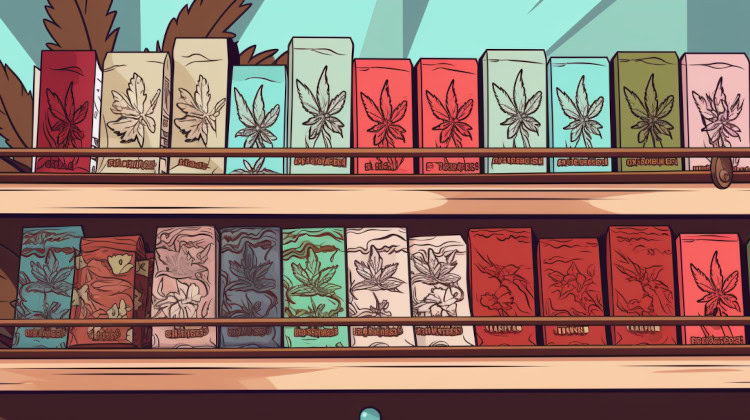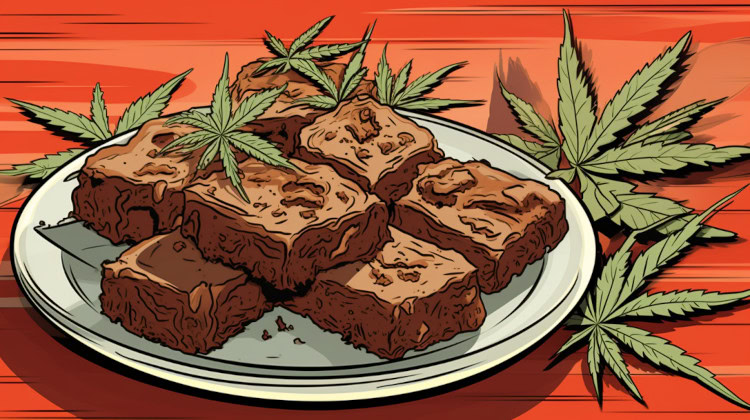In This Article
- Can Weed Help with PTSD?
- Best Types of Edibles for PTSD?
- Gummies
- Baked Goods and Chocolates
- Nano-Infused Edibles
- What Else to Keep In Mind
- How to Choose Edibles for PTSD
- Consider the Ingredients and THC-to-CBD Ratio
- Check the COA and Dosing Instructions
- Personal Preferences and Experimentation
- Making Edibles at Home
- The 5 Best Edibles for PTSD
- 1. WYLD Marionberry Gummies
- 2. Kiva Dark Chocolate CBD 5:1 Bar
- 3. Kush Queen CBG + CBD Gummies
- 4. WYLD Pear CBG Hybrid Enhanced Gummies
- 5. Kiva Churro Milk Chocolate Bar
- Alternatives to Buying Edibles for PTSD
- References
Key Takeaways
- Early research suggests cannabis might help manage PTSD symptoms like anxiety and sleep issues by interacting with the endocannabinoid system.
- Making edibles at home allows for customization, though dosing can be less precise.
- Consider THC-to-CBD ratios and ingredients, and start with a low dose. Gummies, chocolates, and fast-acting options are popular choices.
With a vast array of cannabis edibles available, it can be overwhelming for patients with PTSD to navigate their options. New patients may struggle with the extensive selection, while experienced patients may still not have identified which edibles best suit their needs.
The edible experience is unique to the person, as everyone responds to cannabis differently. Learning different varieties and dosages can help patients narrow down the best edibles for PTSD.
Can Weed Help with PTSD?
Early findings suggest that cannabis may help with PTSD, which is why it is being explored as a potential treatment. Symptoms studied often include sleep quality and duration, nightmares, aversive memories, and anxiety.
Research suggests that it may be primarily due to cannabis interacting with the body's endocannabinoid system (ECS). Researchers associate PTSD with a deficiency in endocannabinoid signaling, particularly a lack of the endocannabinoid anandamide.1
This deficiency may lead to heightened stress responses, excessive threat processing, and anxiety. By activating CB1 receptors and boosting anandamide levles, cannabis might help regulate these responses.2 The right cannabis product may reduce symptoms like fear, anxiety, and unpleasant memories.
The effectiveness of cannabis edibles for PTSD is still under debate. Clinical trials yield varied results, so more robust research is necessary to understand it better. Patients must look at current research and other patient experiences to find what may help them the most.
Some patients with PTSD who use cannabis report significant improvements in their symptoms. In one study, over 65% of participants saw a reduction in at least 20% of their PTSD symptoms. Many reported better sleep quality and reduced anxiety. In fact, nearly 80% of participants saw overall improvement.2
Another study found that patients using cannabis were 2.57 times more likely to no longer meet the criteria for PTSD. This was after one year and compared to those who didn't use cannabis. However, the effectiveness can vary based on factors like the strain, THC-to-CBD ratio, and consumption method.3
Low doses of CBG have also been shown to reduce anxiety, potentially due to its interaction with the serotonin receptors.4
Best Types of Edibles for PTSD?

Edibles are diverse and versatile. Everyone has their own preferences, so when managing PTSD symptoms with edibles, patients often prefer certain types over others. The effects of edibles can vary depending on the individual's metabolism and tolerance level and the product’s cannabinoid content.
Gummies
Gummies are popular for convenience, precise dosing, and enjoyable flavors. Brands like WYLD and Kiva have seen success, with several gummies ranking among the top cannabis edibles in California. Beyond their flavor, gummies also offer a controlled, consistent experience. For patients with PTSD, this might be an essential factor in managing symptoms.
Baked Goods and Chocolates
Some patients may consider baked goods or chocolates as the best edibles for PTSD for many reasons. These varieties offer an indulgent option and have a higher fat content, which helps improve the absorption of cannabinoids like THC and CBD. Since cannabinoids are fat-soluble, combining them with fats allows for better bioavailability and may enhance the intensity of effects.
Nano-Infused Edibles
Fast-acting, nano-infused edibles may be particularly beneficial for PTSD patients. The nanoemulsification process breaks down the THC into smaller molecules, which can speed up the absorption process, resulting in a faster onset time of effects.
While traditional edibles can take upwards of two hours before an onset of effects occurs, nano-emulsified gummies may be felt in as little as 15 minutes. However, there is no guarantee, as everyone is different.
What Else to Keep In Mind
Ultimately, many consumers might benefit from various types of edibles. Regardless, it's essential to consider each edible's ingredients, THC-to-CBD ratios, and other factors. For example, high-THC edibles are reported by many veterans to be more effective in reducing intrusive memories or anxiety. However, they may also increase the risk of paranoia or anxiety in some patients.3
Patients with dietary restrictions or sensitivities may want to avoid edibles with higher sugar content or artificial ingredients. Natural, low-sugar options are viable alternatives. Capsules are a great no-sugar option and are processed in the body similarly to traditional edibles. Some patients report success with capsules.
Other consumers may prefer to make homemade edibles instead. The knowledge and information on how to make edibles at home are easily accessible, with endless recipes across the web for how to make weed gummies and other cannabis-infused foods.
How to Choose Edibles for PTSD
There are several factors to consider when finding edibles to help manage PTSD symptoms. Considering each factor can help patients ensure the best experience possible.
Consider the Ingredients and THC-to-CBD Ratio
An edible’s packaging should always list its ingredients and cannabinoid content. Always review the product's ingredients to ensure it fits your dietary needs. Also, consider whether you'd prefer a high-THC edible, high-CBD edible, or a more balanced option. Likewise, ensure you understand the differences between CBD and THC edibles, as it can help you make a more informed decision.
Check the COA and Dosing Instructions
When choosing an edible, look at the product's certificate of analysis (COA). A COA provides a detailed breakdown of the product's cannabinoid and sometimes terpene profile and helps ensure that it's free from harmful contaminants. Additionally, check the product packaging for clear dosing instructions.
Starting with a low dose, such as 2.5mg to 5mg of THC, gradually increase by 2.5mg to 5mg as needed.5 Many find this a safe approach to finding the right dose without overwhelming effects.
Personal Preferences and Experimentation
Personal preference plays a significant role in choosing the right edible. Some consider gummies and capsules ideal for those who value convenience and precise dosages. Others prefer the rich flavors of baked goods or chocolate. Some may opt for faster-acting solutions, like tinctures or nano-infused edibles.
Overall, it'll come down to which product works best for your specific symptoms. If you must, experiment with different types and dosages to find what resonates the most. It's also important to stay aware of the legal status of edibles in your state. It may influence what options are available to you.
Making Edibles at Home
Making edibles at home is a viable option for those who prefer more control over what goes into them. Homemade means patients can tailor the ingredients and potency to their needs. This is especially important for those with dietary restrictions or specific therapeutic goals. A downside, however, is the dosage of each homemade edible may not be precise.
The 5 Best Edibles for PTSD

Finding the right edible can be the key for some patients to manage their PTSD symptoms. Below are five of the top edibles tailored to specific aspects of PTSD. These are based on patient reviews, cannabinoid content, and more.
1. WYLD Marionberry Gummies
WYLD's Marionberry Gummies have a reputation for helping to manage anxiety and aversive thoughts. As these are two common symptoms of PTSD, some patients may find it beneficial. A consistent dose of THC in each gummy may help regulate mood and reduce anxiety symptoms. Plus, the pleasant marionberry flavor may make it easier for patients to incorporate into their daily routine.
2. Kiva Dark Chocolate CBD 5:1 Bar
A CBD-dominant dark chocolate bar might be a great option for those seeking relief with a sweet tooth. Kiva combines cannabis-infused, rich dark chocolate with a silky smooth texture and hints of vanilla.
At a 5:1 ratio, there are 5mg CBD and 1mg THC per serving. The entire pack contains 20mg THC and 100mg CBD. It allows some consumers to indulge without the risk of overdoing it. The higher CBD content balances THC's effects, which may provide mood-stabilizing benefits. Patients with a clear head may find this balance particularly useful for managing symptoms throughout the day.
Its bittersweet chocolate flavor may add a comforting element for some, which may be soothing during stressful times. Additionally, its high-fat content can help better absorb the cannabinoids during digestion and result in more potent effects.
3. Kush Queen CBG + CBD Gummies
Kush Queen's CBG + CBD Gummies stand out for their unique combination of cannabinoids. They contain CBG, which is known for its anti-inflammatory and neuroprotective potential.4 These gummies might be ideal for patients dealing with the physical symptoms of PTSD. Some patients find that they can better manage their daily activities.
4. WYLD Pear CBG Hybrid Enhanced Gummies
A different sort of balanced effect might come from WYLD's Pear 1:1 THC:CBG Hybrid Enhanced Gummies. The cannabis-infused morsels contain 10mg THC and 10mg CBG per gummy for a total of 100mg each per container. As a result, some patients may find that they offer the effects they seek. CBG's potential effects, combined with THC and added terpenes, may result in "greater rejuvenation,” according to many patients. Likewise, its refreshing pear flavor may provide that light, uplifting experience, enhancing the mood further.
5. Kiva Churro Milk Chocolate Bar
Kiva's Churro Milk Chocolate Bar contains 100mg THC per pack and 5mg THC per serving. Patients who struggle with nightmares and poor sleep quality may find relief with this option. The churro flavor also adds a level of comfort with a dessert-like experience. You might find it as the ideal evening treat before bed.
Alternatives to Buying Edibles for PTSD
Everyone is different, meaning some will want to make the edibles themselves, and that’s okay. There are plenty of recipes online. Become familiar with how to make weed cupcakes, brownies, and more in your very own kitchen.
References
- Abizaid A, Merali Z, Anisman H. Cannabis: A potential efficacious intervention for PTSD or simply snake oil?. J Psychiatry Neurosci. 2019;44(2):75-78. doi:10.1503/jpn.190021 ↩︎
- Nacasch N, Avni C, Toren P. Medical cannabis for treatment-resistant combat PTSD. Frontiers in psychiatry. 2023;13. doi:https://doi.org/10.3389/fpsyt.2022.1014630
↩︎ - Bonn-Miller MO, Brunstetter M, Simonian A, et al. The Long-Term, Prospective, Therapeutic Impact of Cannabis on Post-Traumatic Stress Disorder. Cannabis Cannabinoid Res. 2022;7(2):214-223. doi:10.1089/can.2020.0056 ↩︎
- Russo EB, Cuttler C, Cooper ZD, Stueber A, Whiteley VL, Sexton M. Survey of Patients Employing Cannabigerol-Predominant Cannabis Preparations: Perceived Medical Effects, Adverse Events, and Withdrawal Symptoms. Cannabis Cannabinoid Res. 2022;7(5):706-716. doi:10.1089/can.2021.0058
↩︎ - MacCallum CA, Russo EB. Practical considerations in medical cannabis administration and dosing. European Journal of Internal Medicine. 2018;49(49):12-19. ↩︎
The information in this article and any included images or charts are for educational purposes only. This information is neither a substitute for, nor does it replace, professional legal advice or medical advice, diagnosis, or treatment. If you have any concerns or questions about laws, regulations, or your health, you should always consult with an attorney, physician or other licensed professional.




